London Churchill College: Tesco Business Strategy Analysis Report
VerifiedAdded on 2023/01/12
|11
|3334
|24
Report
AI Summary
This report provides a detailed analysis of Tesco's business strategy, focusing on its internal and external environments. It begins with an introduction to the business environment and then delves into stakeholder analysis, examining customers, shareholders, government, investors, and employees. The report utilizes a stakeholder matrix and mapping to assess stakeholder involvement. It then analyzes the macro environment, highlighting advantages and disadvantages. The report further assesses Tesco's internal environment and capabilities using the VRIO and McKinsey 7'S frameworks, evaluating its strengths, weaknesses, opportunities, and threats through SWOT analysis. Finally, the report applies Porter's Five Forces model to analyze the competitive forces affecting Tesco, including the threat of substitutes and competition within the industry, and concludes with a summary of findings. This report is based on the assignment brief from London Churchill College for the Business Strategy unit.
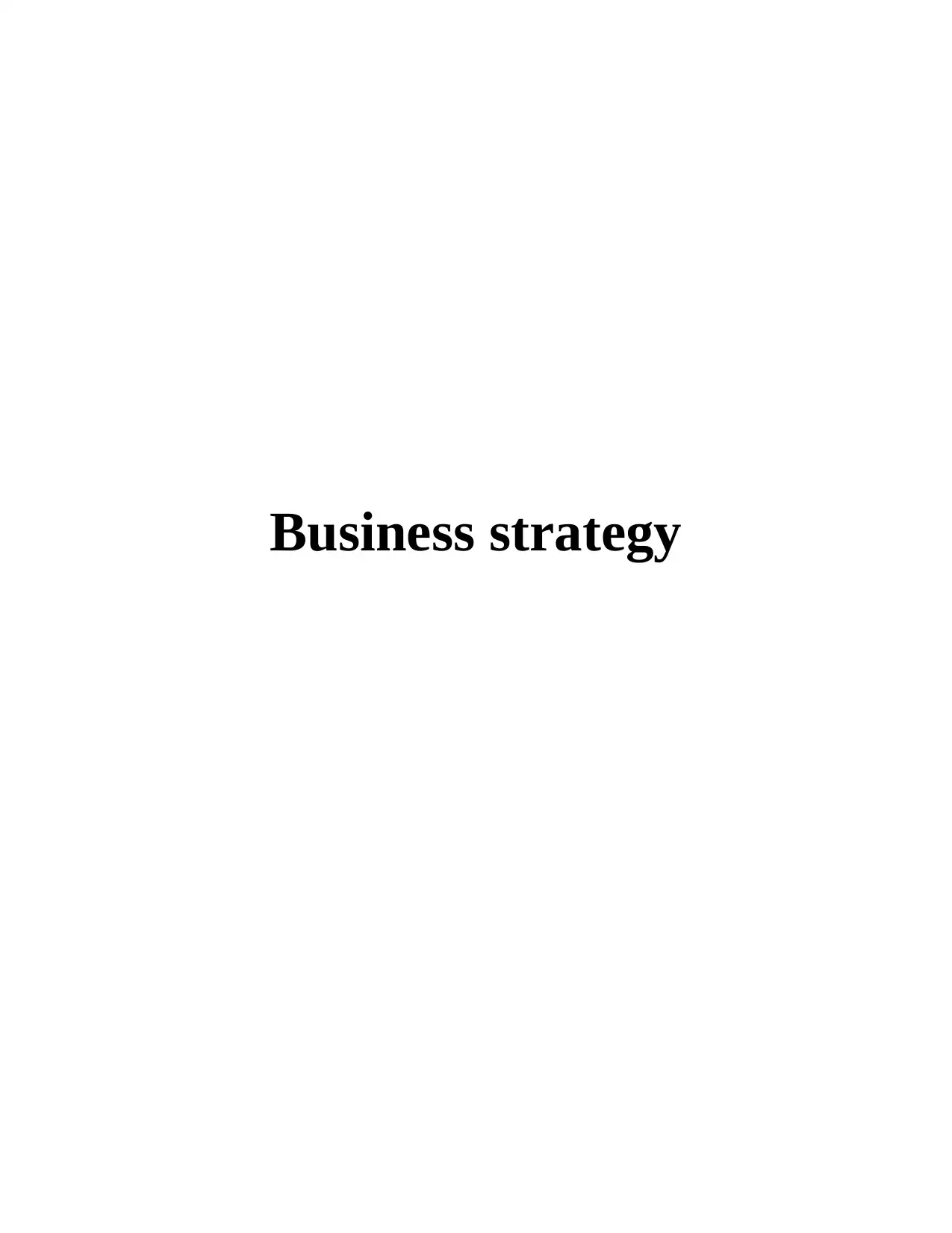
Business strategy
Paraphrase This Document
Need a fresh take? Get an instant paraphrase of this document with our AI Paraphraser
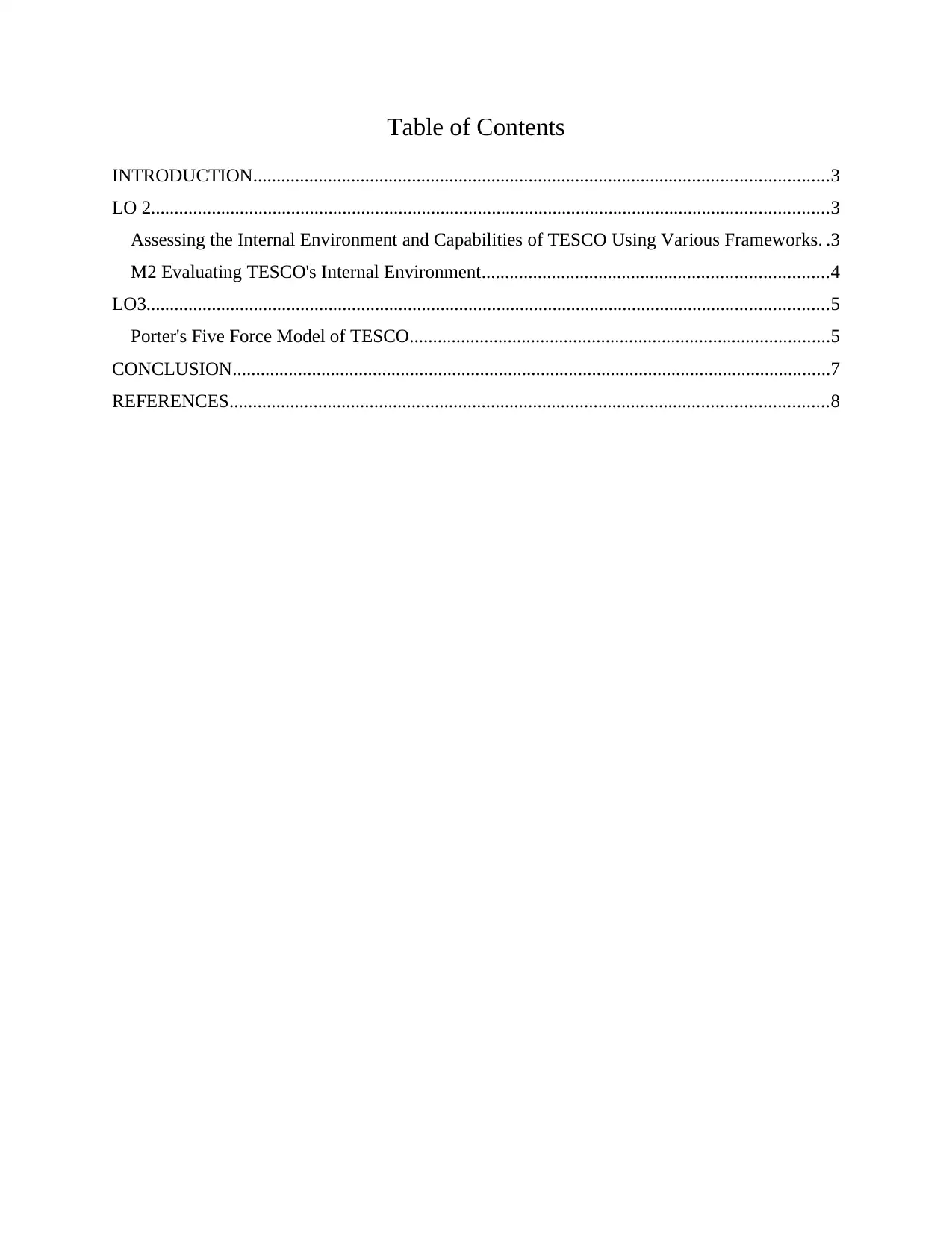
Table of Contents
INTRODUCTION...........................................................................................................................3
LO 2.................................................................................................................................................3
Assessing the Internal Environment and Capabilities of TESCO Using Various Frameworks. .3
M2 Evaluating TESCO's Internal Environment..........................................................................4
LO3..................................................................................................................................................5
Porter's Five Force Model of TESCO..........................................................................................5
CONCLUSION................................................................................................................................7
REFERENCES................................................................................................................................8
INTRODUCTION...........................................................................................................................3
LO 2.................................................................................................................................................3
Assessing the Internal Environment and Capabilities of TESCO Using Various Frameworks. .3
M2 Evaluating TESCO's Internal Environment..........................................................................4
LO3..................................................................................................................................................5
Porter's Five Force Model of TESCO..........................................................................................5
CONCLUSION................................................................................................................................7
REFERENCES................................................................................................................................8

INTRODUCTION
Business environment indicates about the external factors that put an impact over
company's operations in target market. This report is based on the case study of Tesco company.
Company operate its business operations in retail market. This report will project about different
analytical tool like stakeholder analysis, stakeholder matrix and stakeholder mapping. This report
will also emphasis over porter five forces model. Furthermore, this report will also project the
strategical planning of company by applying strategical tool like price leadership and other
strategical tools.
LO1
P1. Analyse the impact and influence of macro environment
Stakeholder are considered as all the internal and external entity's associated with the
business organisation with the support of any operational function. All entity's involved in any
operational role of the company is considered as stakeholder of the company.
Stakeholder Analysis
Stakeholder analysis is about assessing implications of all the associated entities with
business organisation. Organisation structure of Tesco is comprises with the following
stakeholder that can be projected in the following ways.
Customers: Customers of Tesco company is considered as the primary stakeholders of
company. Customers play huge role in sustainability and growth potential of company (Julian,
2016). Stakeholder analysis involve all the existing as well as potential customers that can utilise
the products range of Tesco company. This is an effective aspect of stakeholder analysis as the
company make strategies and policies based on the customers of the company in order to gain
competitive advantages in the target market.
Shareholders: Shareholders of Tesco company is also among the crucial stakeholders of the
company. All funds and investments of company are generated by shareholders of company.
Company management and leaders are responsible for the company's operations to all
shareholders. Due to huge involvement in the profitability of company this analysis influence all
aspects of the company's operational efficiency.
Government: Government is also considered as the important stakeholders of company. All
strategies and policies related to business development and growth has a huge influence of the
policies frame by government. Policies of government related to taxation and other policies
Business environment indicates about the external factors that put an impact over
company's operations in target market. This report is based on the case study of Tesco company.
Company operate its business operations in retail market. This report will project about different
analytical tool like stakeholder analysis, stakeholder matrix and stakeholder mapping. This report
will also emphasis over porter five forces model. Furthermore, this report will also project the
strategical planning of company by applying strategical tool like price leadership and other
strategical tools.
LO1
P1. Analyse the impact and influence of macro environment
Stakeholder are considered as all the internal and external entity's associated with the
business organisation with the support of any operational function. All entity's involved in any
operational role of the company is considered as stakeholder of the company.
Stakeholder Analysis
Stakeholder analysis is about assessing implications of all the associated entities with
business organisation. Organisation structure of Tesco is comprises with the following
stakeholder that can be projected in the following ways.
Customers: Customers of Tesco company is considered as the primary stakeholders of
company. Customers play huge role in sustainability and growth potential of company (Julian,
2016). Stakeholder analysis involve all the existing as well as potential customers that can utilise
the products range of Tesco company. This is an effective aspect of stakeholder analysis as the
company make strategies and policies based on the customers of the company in order to gain
competitive advantages in the target market.
Shareholders: Shareholders of Tesco company is also among the crucial stakeholders of the
company. All funds and investments of company are generated by shareholders of company.
Company management and leaders are responsible for the company's operations to all
shareholders. Due to huge involvement in the profitability of company this analysis influence all
aspects of the company's operational efficiency.
Government: Government is also considered as the important stakeholders of company. All
strategies and policies related to business development and growth has a huge influence of the
policies frame by government. Policies of government related to taxation and other policies
⊘ This is a preview!⊘
Do you want full access?
Subscribe today to unlock all pages.

Trusted by 1+ million students worldwide

effectively influence the pricing strategies and other business development strategies of
company.
Investors: Investors are also among the crucial stakeholders of company. Investors involve
banks, angel investors ad other source of finance that effectively cater the funding needs of
Tesco. Company make effective strategies and policies to project and shine the brand image of
company in target market.
Employee's: Stakeholder analysis put huge emphasis over employee's of company. As the
employee's of company carry huge involvement in all functional activity of company the power
of employee's is high under the stakeholder analysis. Employee's play major role in sustainability
as well as growth of company (Manetti and Bellucci, 2016). Company management of Tesco
make employee development strategies with the support of human resource department of
company to provide potential opportunities to company's employee's to achieve higher growth.
All the above stakeholders are among the primary stakeholders of company. All the
stakeholder impact decision-making and growth perspectives of the Tesco company.
Stakeholder Matrix
Stakeholder matrix also play key role in the stakeholder analysis conducts by the
management of Tesco. The concept of stakeholder matrix is to differentiate stakeholder on the
basis of involvement of stakeholder in the operations of company. Based on the involvement of
stakeholders in company's operations this tool segregate stakeholders into four parts.
High power low interest stakeholder: This is among the crucial stakeholder segment. All the
stakeholders of Tesco company consist with high power but low interest is a part of this
stakeholder segment in stakeholder matrix. Stakeholder of Tesco involve customers and sponsor
are a part of this stakeholder matrix (Rao, Vidhu and Chaitanya, 2016). Customer and sponsor
carry the huge power as both the stakeholders influence to company's sustainability and growth
potentials.
High power high interest stakeholder: All stakeholders of Tesco consist with high power and
interest in company's operations is a part of this stakeholder matrix. All the employees hold
upper designation in Tesco is a part of this stakeholder matrix.
Low interest low power stakeholder: This is also a crucial stakeholder matrix segment. All the
stakeholders of Tesco company comprises with low interest and power is a part of this
company.
Investors: Investors are also among the crucial stakeholders of company. Investors involve
banks, angel investors ad other source of finance that effectively cater the funding needs of
Tesco. Company make effective strategies and policies to project and shine the brand image of
company in target market.
Employee's: Stakeholder analysis put huge emphasis over employee's of company. As the
employee's of company carry huge involvement in all functional activity of company the power
of employee's is high under the stakeholder analysis. Employee's play major role in sustainability
as well as growth of company (Manetti and Bellucci, 2016). Company management of Tesco
make employee development strategies with the support of human resource department of
company to provide potential opportunities to company's employee's to achieve higher growth.
All the above stakeholders are among the primary stakeholders of company. All the
stakeholder impact decision-making and growth perspectives of the Tesco company.
Stakeholder Matrix
Stakeholder matrix also play key role in the stakeholder analysis conducts by the
management of Tesco. The concept of stakeholder matrix is to differentiate stakeholder on the
basis of involvement of stakeholder in the operations of company. Based on the involvement of
stakeholders in company's operations this tool segregate stakeholders into four parts.
High power low interest stakeholder: This is among the crucial stakeholder segment. All the
stakeholders of Tesco company consist with high power but low interest is a part of this
stakeholder segment in stakeholder matrix. Stakeholder of Tesco involve customers and sponsor
are a part of this stakeholder matrix (Rao, Vidhu and Chaitanya, 2016). Customer and sponsor
carry the huge power as both the stakeholders influence to company's sustainability and growth
potentials.
High power high interest stakeholder: All stakeholders of Tesco consist with high power and
interest in company's operations is a part of this stakeholder matrix. All the employees hold
upper designation in Tesco is a part of this stakeholder matrix.
Low interest low power stakeholder: This is also a crucial stakeholder matrix segment. All the
stakeholders of Tesco company comprises with low interest and power is a part of this
Paraphrase This Document
Need a fresh take? Get an instant paraphrase of this document with our AI Paraphraser

stakeholder list. All employee's of Tesco employed at lower designation roles is a part of this
stakeholder matrix list.
High interest low power stakeholder: Stakeholders like suppliers and other associated
stakeholders of Tesco who carry the high interest in company's operations but carry the low
power is a part of this stakeholder matrix.
Based on the involvement of all the stakeholder in company's development process
company management make strategies to cop up with the expectations of all the associated
stakeholder of company.
Stakeholder Mapping
Stakeholder mapping is a strategical tool use by management of Tesco to assess the
involvement of all the associated stakeholder of the company (Santosa and et.al., 2020). Based
on the evaluation conducted under stakeholder mapping management of Tesco frame stakeholder
matrix. This analytical tool segregate stakeholders into four parts.
High Power / High Interest: All stakeholder consist of high power and high interest in the
operations of company is a part of this stakeholder group in stakeholder mapping.
High Power / Low Interest: Based on the evolvement of stakeholders in company's operational
functions all such stakeholders identified who consist of high power but low interest in
company's operations. Stakeholders like customers, government and other respective stakeholder
are a part of this stakeholder mapping group.
Low Power / high Interest: All such stakeholders of company consist with low power but high
interest is a part of this stakeholder segment. Stakeholders like employees are a part of this
stakeholder mapping.
Low Power / Low Interest: All stakeholder consist with low power in company's operations
and also carry low interest is a part of this stakeholder group.
Advantages of macro environment analysis:
In strategy formation.
Improves company's presence in target market.
Disadvantage of macro environment analysis:
Many times this tool misguide the role of stakeholders in company's operations which
also restrict the advantages of this tool.
stakeholder matrix list.
High interest low power stakeholder: Stakeholders like suppliers and other associated
stakeholders of Tesco who carry the high interest in company's operations but carry the low
power is a part of this stakeholder matrix.
Based on the involvement of all the stakeholder in company's development process
company management make strategies to cop up with the expectations of all the associated
stakeholder of company.
Stakeholder Mapping
Stakeholder mapping is a strategical tool use by management of Tesco to assess the
involvement of all the associated stakeholder of the company (Santosa and et.al., 2020). Based
on the evaluation conducted under stakeholder mapping management of Tesco frame stakeholder
matrix. This analytical tool segregate stakeholders into four parts.
High Power / High Interest: All stakeholder consist of high power and high interest in the
operations of company is a part of this stakeholder group in stakeholder mapping.
High Power / Low Interest: Based on the evolvement of stakeholders in company's operational
functions all such stakeholders identified who consist of high power but low interest in
company's operations. Stakeholders like customers, government and other respective stakeholder
are a part of this stakeholder mapping group.
Low Power / high Interest: All such stakeholders of company consist with low power but high
interest is a part of this stakeholder segment. Stakeholders like employees are a part of this
stakeholder mapping.
Low Power / Low Interest: All stakeholder consist with low power in company's operations
and also carry low interest is a part of this stakeholder group.
Advantages of macro environment analysis:
In strategy formation.
Improves company's presence in target market.
Disadvantage of macro environment analysis:
Many times this tool misguide the role of stakeholders in company's operations which
also restrict the advantages of this tool.
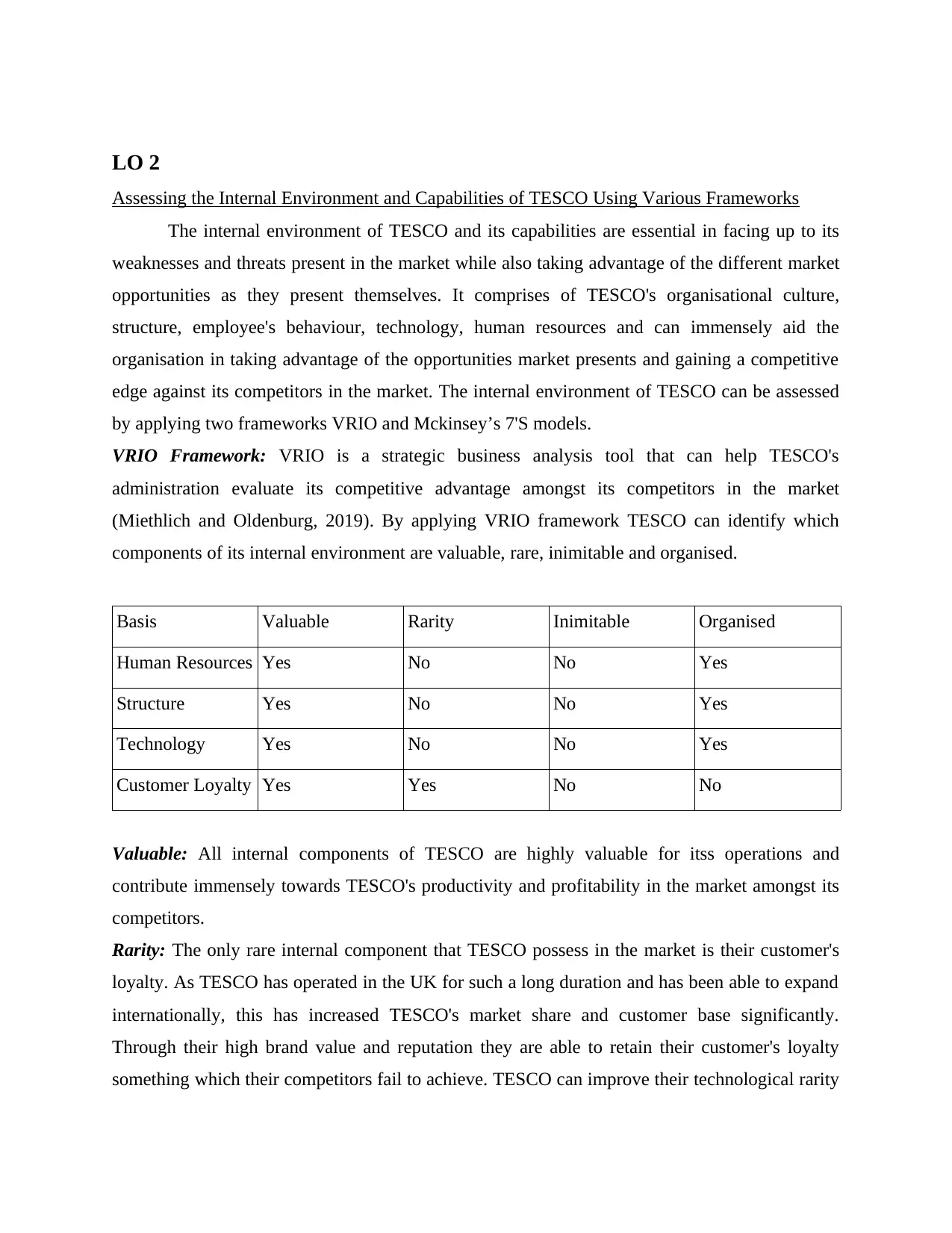
LO 2
Assessing the Internal Environment and Capabilities of TESCO Using Various Frameworks
The internal environment of TESCO and its capabilities are essential in facing up to its
weaknesses and threats present in the market while also taking advantage of the different market
opportunities as they present themselves. It comprises of TESCO's organisational culture,
structure, employee's behaviour, technology, human resources and can immensely aid the
organisation in taking advantage of the opportunities market presents and gaining a competitive
edge against its competitors in the market. The internal environment of TESCO can be assessed
by applying two frameworks VRIO and Mckinsey’s 7'S models.
VRIO Framework: VRIO is a strategic business analysis tool that can help TESCO's
administration evaluate its competitive advantage amongst its competitors in the market
(Miethlich and Oldenburg, 2019). By applying VRIO framework TESCO can identify which
components of its internal environment are valuable, rare, inimitable and organised.
Basis Valuable Rarity Inimitable Organised
Human Resources Yes No No Yes
Structure Yes No No Yes
Technology Yes No No Yes
Customer Loyalty Yes Yes No No
Valuable: All internal components of TESCO are highly valuable for itss operations and
contribute immensely towards TESCO's productivity and profitability in the market amongst its
competitors.
Rarity: The only rare internal component that TESCO possess in the market is their customer's
loyalty. As TESCO has operated in the UK for such a long duration and has been able to expand
internationally, this has increased TESCO's market share and customer base significantly.
Through their high brand value and reputation they are able to retain their customer's loyalty
something which their competitors fail to achieve. TESCO can improve their technological rarity
Assessing the Internal Environment and Capabilities of TESCO Using Various Frameworks
The internal environment of TESCO and its capabilities are essential in facing up to its
weaknesses and threats present in the market while also taking advantage of the different market
opportunities as they present themselves. It comprises of TESCO's organisational culture,
structure, employee's behaviour, technology, human resources and can immensely aid the
organisation in taking advantage of the opportunities market presents and gaining a competitive
edge against its competitors in the market. The internal environment of TESCO can be assessed
by applying two frameworks VRIO and Mckinsey’s 7'S models.
VRIO Framework: VRIO is a strategic business analysis tool that can help TESCO's
administration evaluate its competitive advantage amongst its competitors in the market
(Miethlich and Oldenburg, 2019). By applying VRIO framework TESCO can identify which
components of its internal environment are valuable, rare, inimitable and organised.
Basis Valuable Rarity Inimitable Organised
Human Resources Yes No No Yes
Structure Yes No No Yes
Technology Yes No No Yes
Customer Loyalty Yes Yes No No
Valuable: All internal components of TESCO are highly valuable for itss operations and
contribute immensely towards TESCO's productivity and profitability in the market amongst its
competitors.
Rarity: The only rare internal component that TESCO possess in the market is their customer's
loyalty. As TESCO has operated in the UK for such a long duration and has been able to expand
internationally, this has increased TESCO's market share and customer base significantly.
Through their high brand value and reputation they are able to retain their customer's loyalty
something which their competitors fail to achieve. TESCO can improve their technological rarity
⊘ This is a preview!⊘
Do you want full access?
Subscribe today to unlock all pages.

Trusted by 1+ million students worldwide
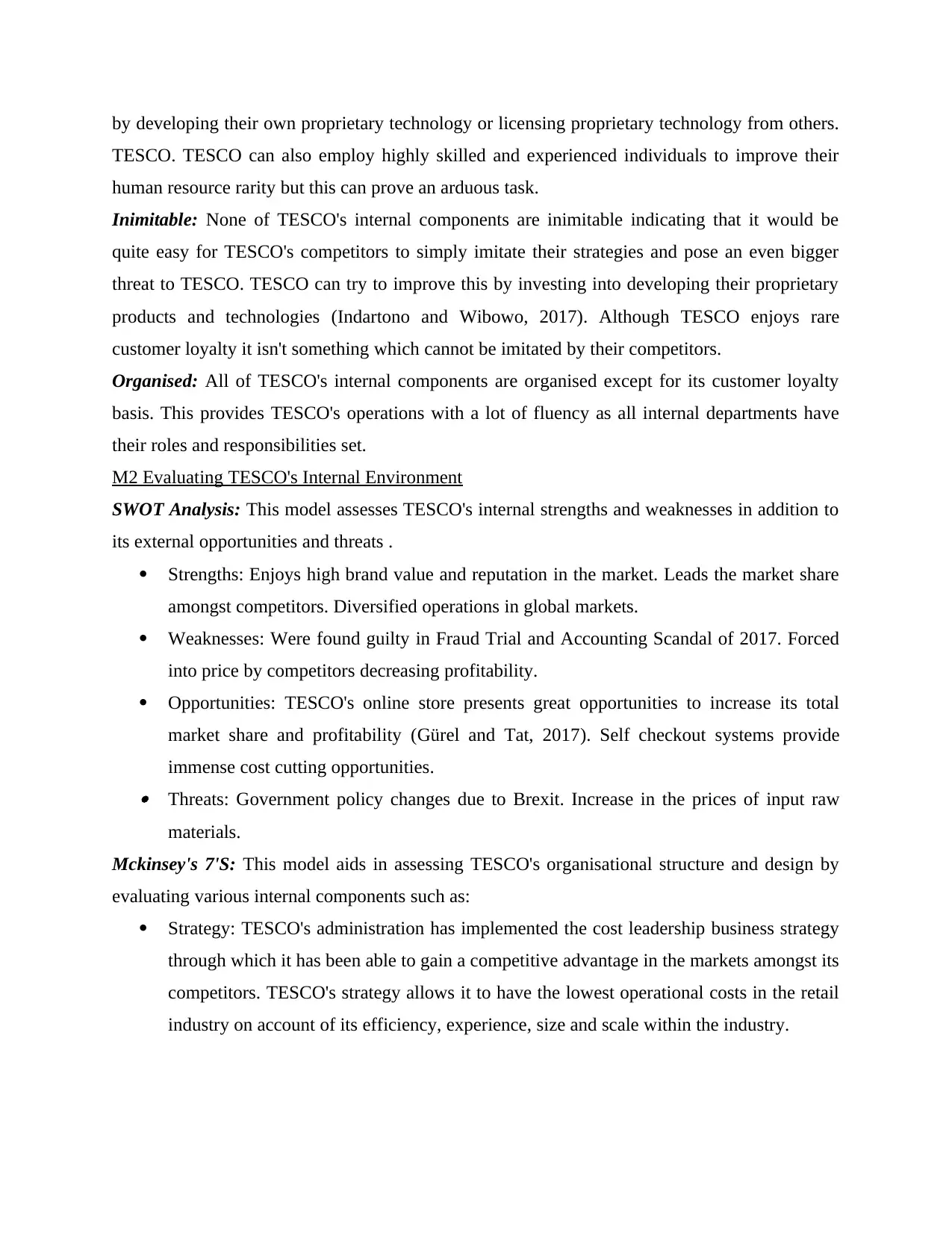
by developing their own proprietary technology or licensing proprietary technology from others.
TESCO. TESCO can also employ highly skilled and experienced individuals to improve their
human resource rarity but this can prove an arduous task.
Inimitable: None of TESCO's internal components are inimitable indicating that it would be
quite easy for TESCO's competitors to simply imitate their strategies and pose an even bigger
threat to TESCO. TESCO can try to improve this by investing into developing their proprietary
products and technologies (Indartono and Wibowo, 2017). Although TESCO enjoys rare
customer loyalty it isn't something which cannot be imitated by their competitors.
Organised: All of TESCO's internal components are organised except for its customer loyalty
basis. This provides TESCO's operations with a lot of fluency as all internal departments have
their roles and responsibilities set.
M2 Evaluating TESCO's Internal Environment
SWOT Analysis: This model assesses TESCO's internal strengths and weaknesses in addition to
its external opportunities and threats .
Strengths: Enjoys high brand value and reputation in the market. Leads the market share
amongst competitors. Diversified operations in global markets.
Weaknesses: Were found guilty in Fraud Trial and Accounting Scandal of 2017. Forced
into price by competitors decreasing profitability.
Opportunities: TESCO's online store presents great opportunities to increase its total
market share and profitability (Gürel and Tat, 2017). Self checkout systems provide
immense cost cutting opportunities. Threats: Government policy changes due to Brexit. Increase in the prices of input raw
materials.
Mckinsey's 7'S: This model aids in assessing TESCO's organisational structure and design by
evaluating various internal components such as:
Strategy: TESCO's administration has implemented the cost leadership business strategy
through which it has been able to gain a competitive advantage in the markets amongst its
competitors. TESCO's strategy allows it to have the lowest operational costs in the retail
industry on account of its efficiency, experience, size and scale within the industry.
TESCO. TESCO can also employ highly skilled and experienced individuals to improve their
human resource rarity but this can prove an arduous task.
Inimitable: None of TESCO's internal components are inimitable indicating that it would be
quite easy for TESCO's competitors to simply imitate their strategies and pose an even bigger
threat to TESCO. TESCO can try to improve this by investing into developing their proprietary
products and technologies (Indartono and Wibowo, 2017). Although TESCO enjoys rare
customer loyalty it isn't something which cannot be imitated by their competitors.
Organised: All of TESCO's internal components are organised except for its customer loyalty
basis. This provides TESCO's operations with a lot of fluency as all internal departments have
their roles and responsibilities set.
M2 Evaluating TESCO's Internal Environment
SWOT Analysis: This model assesses TESCO's internal strengths and weaknesses in addition to
its external opportunities and threats .
Strengths: Enjoys high brand value and reputation in the market. Leads the market share
amongst competitors. Diversified operations in global markets.
Weaknesses: Were found guilty in Fraud Trial and Accounting Scandal of 2017. Forced
into price by competitors decreasing profitability.
Opportunities: TESCO's online store presents great opportunities to increase its total
market share and profitability (Gürel and Tat, 2017). Self checkout systems provide
immense cost cutting opportunities. Threats: Government policy changes due to Brexit. Increase in the prices of input raw
materials.
Mckinsey's 7'S: This model aids in assessing TESCO's organisational structure and design by
evaluating various internal components such as:
Strategy: TESCO's administration has implemented the cost leadership business strategy
through which it has been able to gain a competitive advantage in the markets amongst its
competitors. TESCO's strategy allows it to have the lowest operational costs in the retail
industry on account of its efficiency, experience, size and scale within the industry.
Paraphrase This Document
Need a fresh take? Get an instant paraphrase of this document with our AI Paraphraser
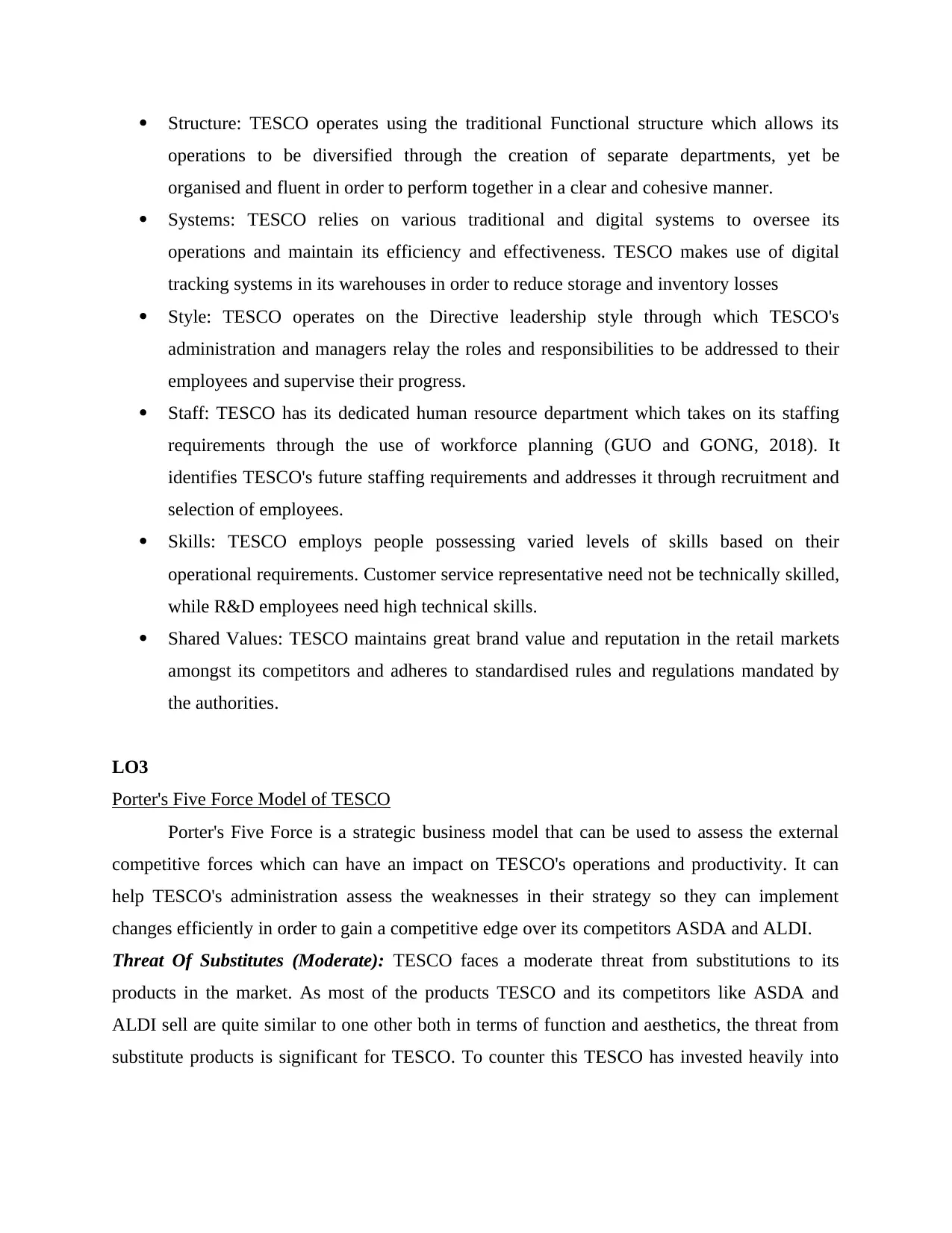
Structure: TESCO operates using the traditional Functional structure which allows its
operations to be diversified through the creation of separate departments, yet be
organised and fluent in order to perform together in a clear and cohesive manner.
Systems: TESCO relies on various traditional and digital systems to oversee its
operations and maintain its efficiency and effectiveness. TESCO makes use of digital
tracking systems in its warehouses in order to reduce storage and inventory losses
Style: TESCO operates on the Directive leadership style through which TESCO's
administration and managers relay the roles and responsibilities to be addressed to their
employees and supervise their progress.
Staff: TESCO has its dedicated human resource department which takes on its staffing
requirements through the use of workforce planning (GUO and GONG, 2018). It
identifies TESCO's future staffing requirements and addresses it through recruitment and
selection of employees.
Skills: TESCO employs people possessing varied levels of skills based on their
operational requirements. Customer service representative need not be technically skilled,
while R&D employees need high technical skills.
Shared Values: TESCO maintains great brand value and reputation in the retail markets
amongst its competitors and adheres to standardised rules and regulations mandated by
the authorities.
LO3
Porter's Five Force Model of TESCO
Porter's Five Force is a strategic business model that can be used to assess the external
competitive forces which can have an impact on TESCO's operations and productivity. It can
help TESCO's administration assess the weaknesses in their strategy so they can implement
changes efficiently in order to gain a competitive edge over its competitors ASDA and ALDI.
Threat Of Substitutes (Moderate): TESCO faces a moderate threat from substitutions to its
products in the market. As most of the products TESCO and its competitors like ASDA and
ALDI sell are quite similar to one other both in terms of function and aesthetics, the threat from
substitute products is significant for TESCO. To counter this TESCO has invested heavily into
operations to be diversified through the creation of separate departments, yet be
organised and fluent in order to perform together in a clear and cohesive manner.
Systems: TESCO relies on various traditional and digital systems to oversee its
operations and maintain its efficiency and effectiveness. TESCO makes use of digital
tracking systems in its warehouses in order to reduce storage and inventory losses
Style: TESCO operates on the Directive leadership style through which TESCO's
administration and managers relay the roles and responsibilities to be addressed to their
employees and supervise their progress.
Staff: TESCO has its dedicated human resource department which takes on its staffing
requirements through the use of workforce planning (GUO and GONG, 2018). It
identifies TESCO's future staffing requirements and addresses it through recruitment and
selection of employees.
Skills: TESCO employs people possessing varied levels of skills based on their
operational requirements. Customer service representative need not be technically skilled,
while R&D employees need high technical skills.
Shared Values: TESCO maintains great brand value and reputation in the retail markets
amongst its competitors and adheres to standardised rules and regulations mandated by
the authorities.
LO3
Porter's Five Force Model of TESCO
Porter's Five Force is a strategic business model that can be used to assess the external
competitive forces which can have an impact on TESCO's operations and productivity. It can
help TESCO's administration assess the weaknesses in their strategy so they can implement
changes efficiently in order to gain a competitive edge over its competitors ASDA and ALDI.
Threat Of Substitutes (Moderate): TESCO faces a moderate threat from substitutions to its
products in the market. As most of the products TESCO and its competitors like ASDA and
ALDI sell are quite similar to one other both in terms of function and aesthetics, the threat from
substitute products is significant for TESCO. To counter this TESCO has invested heavily into
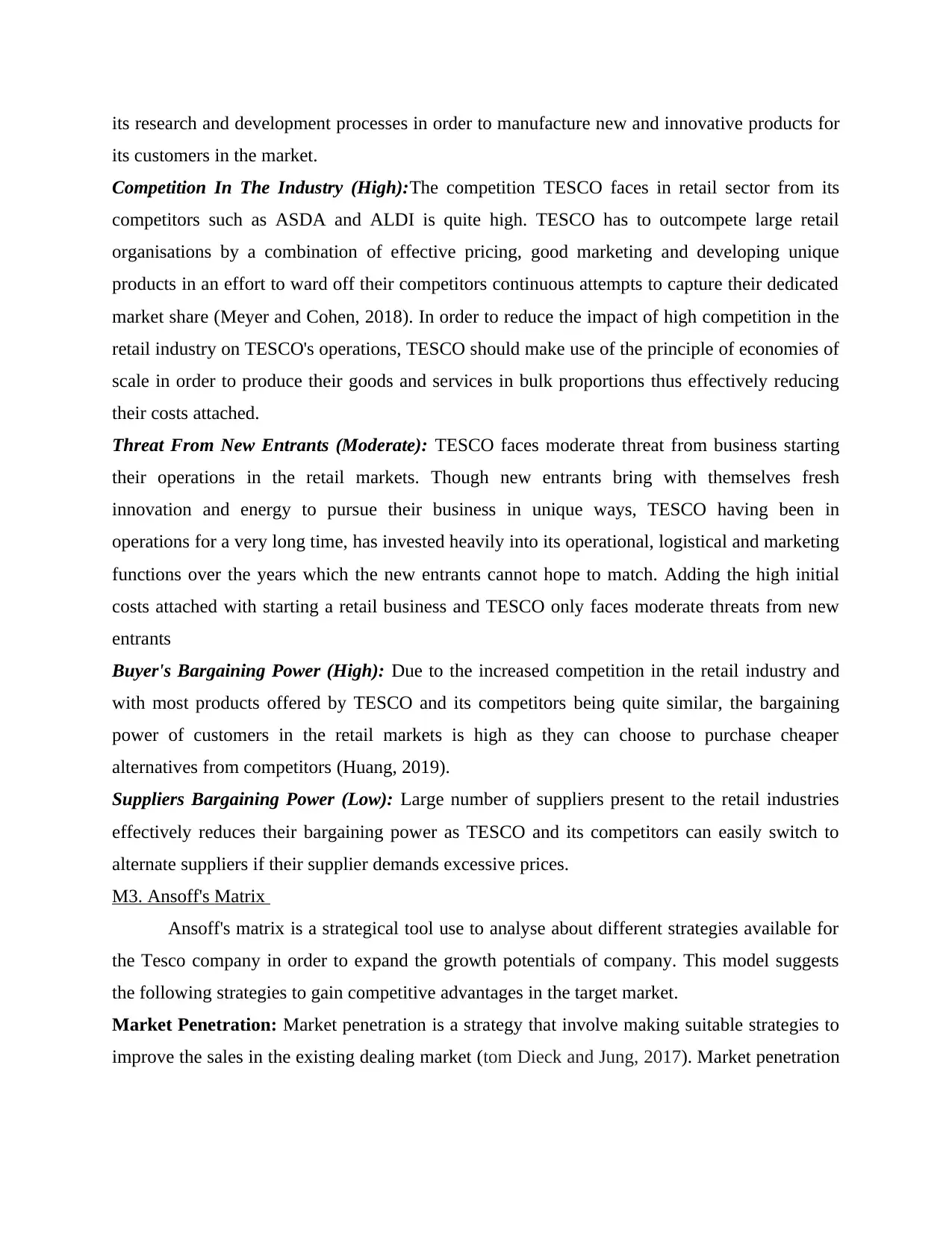
its research and development processes in order to manufacture new and innovative products for
its customers in the market.
Competition In The Industry (High):The competition TESCO faces in retail sector from its
competitors such as ASDA and ALDI is quite high. TESCO has to outcompete large retail
organisations by a combination of effective pricing, good marketing and developing unique
products in an effort to ward off their competitors continuous attempts to capture their dedicated
market share (Meyer and Cohen, 2018). In order to reduce the impact of high competition in the
retail industry on TESCO's operations, TESCO should make use of the principle of economies of
scale in order to produce their goods and services in bulk proportions thus effectively reducing
their costs attached.
Threat From New Entrants (Moderate): TESCO faces moderate threat from business starting
their operations in the retail markets. Though new entrants bring with themselves fresh
innovation and energy to pursue their business in unique ways, TESCO having been in
operations for a very long time, has invested heavily into its operational, logistical and marketing
functions over the years which the new entrants cannot hope to match. Adding the high initial
costs attached with starting a retail business and TESCO only faces moderate threats from new
entrants
Buyer's Bargaining Power (High): Due to the increased competition in the retail industry and
with most products offered by TESCO and its competitors being quite similar, the bargaining
power of customers in the retail markets is high as they can choose to purchase cheaper
alternatives from competitors (Huang, 2019).
Suppliers Bargaining Power (Low): Large number of suppliers present to the retail industries
effectively reduces their bargaining power as TESCO and its competitors can easily switch to
alternate suppliers if their supplier demands excessive prices.
M3. Ansoff's Matrix
Ansoff's matrix is a strategical tool use to analyse about different strategies available for
the Tesco company in order to expand the growth potentials of company. This model suggests
the following strategies to gain competitive advantages in the target market.
Market Penetration: Market penetration is a strategy that involve making suitable strategies to
improve the sales in the existing dealing market (tom Dieck and Jung, 2017). Market penetration
its customers in the market.
Competition In The Industry (High):The competition TESCO faces in retail sector from its
competitors such as ASDA and ALDI is quite high. TESCO has to outcompete large retail
organisations by a combination of effective pricing, good marketing and developing unique
products in an effort to ward off their competitors continuous attempts to capture their dedicated
market share (Meyer and Cohen, 2018). In order to reduce the impact of high competition in the
retail industry on TESCO's operations, TESCO should make use of the principle of economies of
scale in order to produce their goods and services in bulk proportions thus effectively reducing
their costs attached.
Threat From New Entrants (Moderate): TESCO faces moderate threat from business starting
their operations in the retail markets. Though new entrants bring with themselves fresh
innovation and energy to pursue their business in unique ways, TESCO having been in
operations for a very long time, has invested heavily into its operational, logistical and marketing
functions over the years which the new entrants cannot hope to match. Adding the high initial
costs attached with starting a retail business and TESCO only faces moderate threats from new
entrants
Buyer's Bargaining Power (High): Due to the increased competition in the retail industry and
with most products offered by TESCO and its competitors being quite similar, the bargaining
power of customers in the retail markets is high as they can choose to purchase cheaper
alternatives from competitors (Huang, 2019).
Suppliers Bargaining Power (Low): Large number of suppliers present to the retail industries
effectively reduces their bargaining power as TESCO and its competitors can easily switch to
alternate suppliers if their supplier demands excessive prices.
M3. Ansoff's Matrix
Ansoff's matrix is a strategical tool use to analyse about different strategies available for
the Tesco company in order to expand the growth potentials of company. This model suggests
the following strategies to gain competitive advantages in the target market.
Market Penetration: Market penetration is a strategy that involve making suitable strategies to
improve the sales in the existing dealing market (tom Dieck and Jung, 2017). Market penetration
⊘ This is a preview!⊘
Do you want full access?
Subscribe today to unlock all pages.

Trusted by 1+ million students worldwide
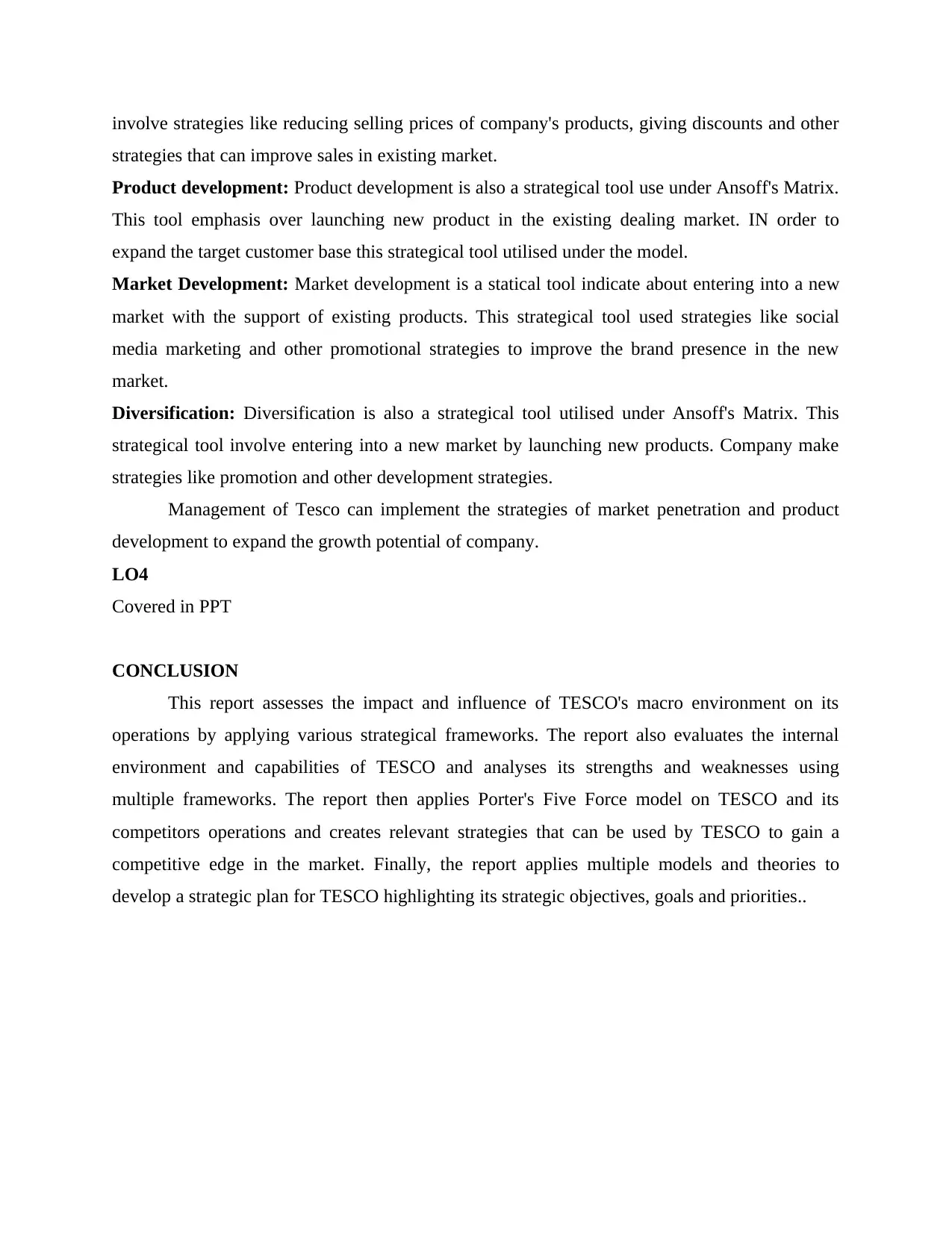
involve strategies like reducing selling prices of company's products, giving discounts and other
strategies that can improve sales in existing market.
Product development: Product development is also a strategical tool use under Ansoff's Matrix.
This tool emphasis over launching new product in the existing dealing market. IN order to
expand the target customer base this strategical tool utilised under the model.
Market Development: Market development is a statical tool indicate about entering into a new
market with the support of existing products. This strategical tool used strategies like social
media marketing and other promotional strategies to improve the brand presence in the new
market.
Diversification: Diversification is also a strategical tool utilised under Ansoff's Matrix. This
strategical tool involve entering into a new market by launching new products. Company make
strategies like promotion and other development strategies.
Management of Tesco can implement the strategies of market penetration and product
development to expand the growth potential of company.
LO4
Covered in PPT
CONCLUSION
This report assesses the impact and influence of TESCO's macro environment on its
operations by applying various strategical frameworks. The report also evaluates the internal
environment and capabilities of TESCO and analyses its strengths and weaknesses using
multiple frameworks. The report then applies Porter's Five Force model on TESCO and its
competitors operations and creates relevant strategies that can be used by TESCO to gain a
competitive edge in the market. Finally, the report applies multiple models and theories to
develop a strategic plan for TESCO highlighting its strategic objectives, goals and priorities..
strategies that can improve sales in existing market.
Product development: Product development is also a strategical tool use under Ansoff's Matrix.
This tool emphasis over launching new product in the existing dealing market. IN order to
expand the target customer base this strategical tool utilised under the model.
Market Development: Market development is a statical tool indicate about entering into a new
market with the support of existing products. This strategical tool used strategies like social
media marketing and other promotional strategies to improve the brand presence in the new
market.
Diversification: Diversification is also a strategical tool utilised under Ansoff's Matrix. This
strategical tool involve entering into a new market by launching new products. Company make
strategies like promotion and other development strategies.
Management of Tesco can implement the strategies of market penetration and product
development to expand the growth potential of company.
LO4
Covered in PPT
CONCLUSION
This report assesses the impact and influence of TESCO's macro environment on its
operations by applying various strategical frameworks. The report also evaluates the internal
environment and capabilities of TESCO and analyses its strengths and weaknesses using
multiple frameworks. The report then applies Porter's Five Force model on TESCO and its
competitors operations and creates relevant strategies that can be used by TESCO to gain a
competitive edge in the market. Finally, the report applies multiple models and theories to
develop a strategic plan for TESCO highlighting its strategic objectives, goals and priorities..
Paraphrase This Document
Need a fresh take? Get an instant paraphrase of this document with our AI Paraphraser
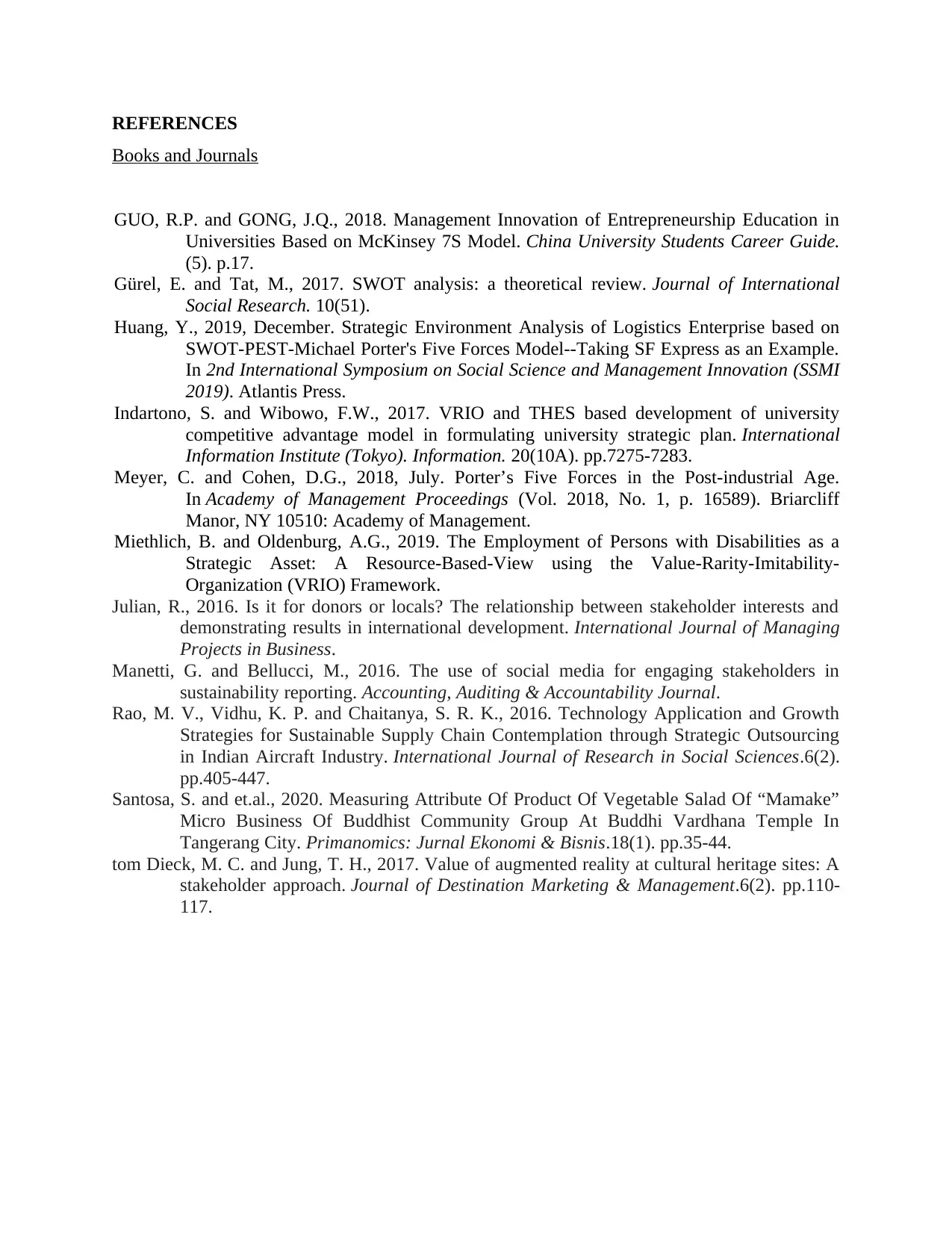
REFERENCES
Books and Journals
GUO, R.P. and GONG, J.Q., 2018. Management Innovation of Entrepreneurship Education in
Universities Based on McKinsey 7S Model. China University Students Career Guide.
(5). p.17.
Gürel, E. and Tat, M., 2017. SWOT analysis: a theoretical review. Journal of International
Social Research. 10(51).
Huang, Y., 2019, December. Strategic Environment Analysis of Logistics Enterprise based on
SWOT-PEST-Michael Porter's Five Forces Model--Taking SF Express as an Example.
In 2nd International Symposium on Social Science and Management Innovation (SSMI
2019). Atlantis Press.
Indartono, S. and Wibowo, F.W., 2017. VRIO and THES based development of university
competitive advantage model in formulating university strategic plan. International
Information Institute (Tokyo). Information. 20(10A). pp.7275-7283.
Meyer, C. and Cohen, D.G., 2018, July. Porter’s Five Forces in the Post-industrial Age.
In Academy of Management Proceedings (Vol. 2018, No. 1, p. 16589). Briarcliff
Manor, NY 10510: Academy of Management.
Miethlich, B. and Oldenburg, A.G., 2019. The Employment of Persons with Disabilities as a
Strategic Asset: A Resource-Based-View using the Value-Rarity-Imitability-
Organization (VRIO) Framework.
Julian, R., 2016. Is it for donors or locals? The relationship between stakeholder interests and
demonstrating results in international development. International Journal of Managing
Projects in Business.
Manetti, G. and Bellucci, M., 2016. The use of social media for engaging stakeholders in
sustainability reporting. Accounting, Auditing & Accountability Journal.
Rao, M. V., Vidhu, K. P. and Chaitanya, S. R. K., 2016. Technology Application and Growth
Strategies for Sustainable Supply Chain Contemplation through Strategic Outsourcing
in Indian Aircraft Industry. International Journal of Research in Social Sciences.6(2).
pp.405-447.
Santosa, S. and et.al., 2020. Measuring Attribute Of Product Of Vegetable Salad Of “Mamake”
Micro Business Of Buddhist Community Group At Buddhi Vardhana Temple In
Tangerang City. Primanomics: Jurnal Ekonomi & Bisnis.18(1). pp.35-44.
tom Dieck, M. C. and Jung, T. H., 2017. Value of augmented reality at cultural heritage sites: A
stakeholder approach. Journal of Destination Marketing & Management.6(2). pp.110-
117.
Books and Journals
GUO, R.P. and GONG, J.Q., 2018. Management Innovation of Entrepreneurship Education in
Universities Based on McKinsey 7S Model. China University Students Career Guide.
(5). p.17.
Gürel, E. and Tat, M., 2017. SWOT analysis: a theoretical review. Journal of International
Social Research. 10(51).
Huang, Y., 2019, December. Strategic Environment Analysis of Logistics Enterprise based on
SWOT-PEST-Michael Porter's Five Forces Model--Taking SF Express as an Example.
In 2nd International Symposium on Social Science and Management Innovation (SSMI
2019). Atlantis Press.
Indartono, S. and Wibowo, F.W., 2017. VRIO and THES based development of university
competitive advantage model in formulating university strategic plan. International
Information Institute (Tokyo). Information. 20(10A). pp.7275-7283.
Meyer, C. and Cohen, D.G., 2018, July. Porter’s Five Forces in the Post-industrial Age.
In Academy of Management Proceedings (Vol. 2018, No. 1, p. 16589). Briarcliff
Manor, NY 10510: Academy of Management.
Miethlich, B. and Oldenburg, A.G., 2019. The Employment of Persons with Disabilities as a
Strategic Asset: A Resource-Based-View using the Value-Rarity-Imitability-
Organization (VRIO) Framework.
Julian, R., 2016. Is it for donors or locals? The relationship between stakeholder interests and
demonstrating results in international development. International Journal of Managing
Projects in Business.
Manetti, G. and Bellucci, M., 2016. The use of social media for engaging stakeholders in
sustainability reporting. Accounting, Auditing & Accountability Journal.
Rao, M. V., Vidhu, K. P. and Chaitanya, S. R. K., 2016. Technology Application and Growth
Strategies for Sustainable Supply Chain Contemplation through Strategic Outsourcing
in Indian Aircraft Industry. International Journal of Research in Social Sciences.6(2).
pp.405-447.
Santosa, S. and et.al., 2020. Measuring Attribute Of Product Of Vegetable Salad Of “Mamake”
Micro Business Of Buddhist Community Group At Buddhi Vardhana Temple In
Tangerang City. Primanomics: Jurnal Ekonomi & Bisnis.18(1). pp.35-44.
tom Dieck, M. C. and Jung, T. H., 2017. Value of augmented reality at cultural heritage sites: A
stakeholder approach. Journal of Destination Marketing & Management.6(2). pp.110-
117.
1 out of 11
Related Documents
Your All-in-One AI-Powered Toolkit for Academic Success.
+13062052269
info@desklib.com
Available 24*7 on WhatsApp / Email
![[object Object]](/_next/static/media/star-bottom.7253800d.svg)
Unlock your academic potential
Copyright © 2020–2025 A2Z Services. All Rights Reserved. Developed and managed by ZUCOL.





